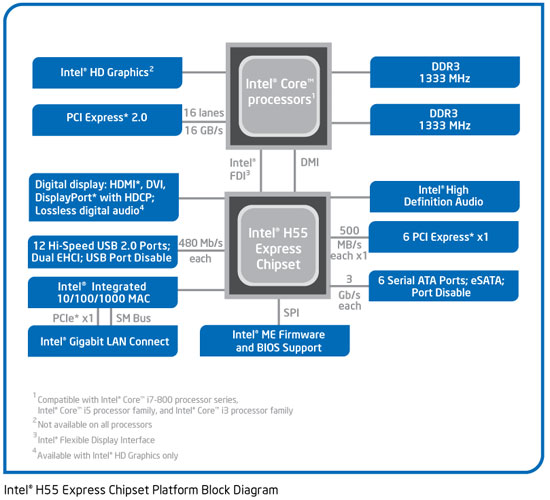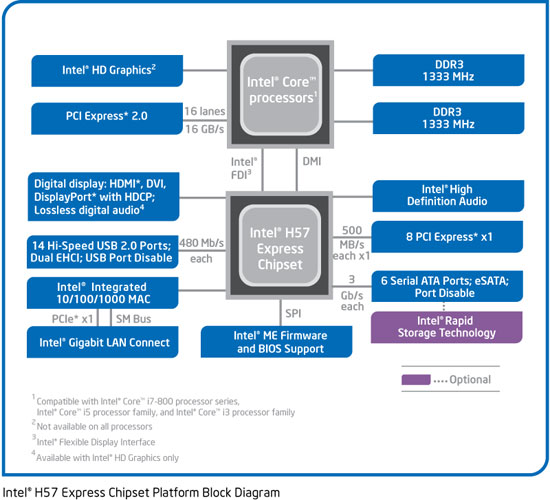Choosing the Best H55/H57 Motherboard - Part 1
by Rajinder Gill on January 31, 2010 11:30 PM EST- Posted in
- Motherboards
January 3, 2010 saw the lift of Intel's embargo on the Clarkdale family of processors and supporting H55/H57 series chipsets. Boards featuring these chipsets have been in our labs for a few weeks now, and we have been busy testing them to figure out which one makes the most sense to buy. After a solid two weeks on the merry-go-round, leaving us with eye-bags larger than potato sacks and eyeballs redder than a Baboon's backside, we are finally in a position to deliver part one of our coverage.
Before we continue further, it makes sense to start with a couple of H55 and H57 chipset diagrams for a refresher and overview:


| Intel Chipset Pricing | |
| Chipset | Pricing (1000 units) |
| Intel Q57 | $44 |
| Intel H55 | $40 |
| Intel H57 | $43 |
| Intel P55 | $40 |
The diagrams lay out the topology simply enough; what they don't make clear is that Clarkdale CPUs are confined to single GPU configurations by Intel when used in conjunction with H55/H57 motherboards. That does not mean to say that you can't run dual GPU configurations on H55/H57 altogether though; you can if you use a Lynnfield series processor, if the motherboard vendor has taken the trouble of placing the appropriate lane switches onto the board.
The only way to get dual GPU capabilities from Clarkdale CPUs is to use them in a supporting P55 motherboard. Weird, no? The segregation would make sense if Intel offered the H55 and H57 chipsets to vendors at a substantially reduced price in comparison to P55. Clearly, that's not happening at present, as the H57 costs $3 more than the P55 before you've even put a component on the motherboard.
So where does this leave H57? The only thing it has to offer Clarkdale is a few extra PCI-E lanes, two extra USB ports, and RAID. If you're going to use the IGP, you don't really need the extra PCI-E lanes, which essentially means that you're paying for the option to run RAID on the H57 PCH. We also fail to see the attraction of running a Lynnfield processor in an H57 board; the H57 boards would need to come in at least $20 cheaper than entry level P55 boards, or offer some form of performance enhancement for it to start making sense.
In light of this, we're expecting vendors to bring H55 boards at a maximum of $130 (hopefully less), while H57 boards should be offered at a price reflecting the difference in chipset and associated parts costs only. The $150~$200 bracket is best left to mid/upper tier P55 motherboards and entry level X58 offerings, rather than have H57 competing in these segments.
Our focus for this two part series is to look primarily at the sub-$150 H55/H57 motherboards. A $200 board did make it into the test lineup before the dual GPU information was made clear to us by Intel and the board vendors. We've kept it in the running for now, just to see what H57 offers over H55 in terms of performance and overclocking.
Today's full lineup of test subjects is the ASUS P7H55D-M EVO, ASUS P7H57D-V EVO, the ASRock H55M-Pro, and the MSI H55M-ED55. Don't be alarmed if you don't see your favorite vendor in the current test list; two boards from Gigabyte have just touched base in our labs, while boards from BIOSTAR and ECS are currently en route. We'll be looking at all of those in part two of our coverage, where we'll also offer up our final verdict on the best choice.
We've got plenty of fat to chew over in part one first, so let's move on to our user experience summary of each board before we focus on the finer elements of today's test samples.










56 Comments
View All Comments
Rajinder Gill - Monday, February 1, 2010 - link
Hi Rick,I have not heard of or seen anything that offers 10 onboard SATA ports on H55 yet. If I hear of anything, I'll let you know.
regards
Raja
Rick83 - Monday, February 1, 2010 - link
Many thanks :-)marc1000 - Monday, February 1, 2010 - link
Bottom line: DON'T BUY anything from Intel this generation. If you are not an advanced user who knows exactly what you are doing, then it is best to skip completely the current products.I'm saying this because there is a great chance you will pay more for something that offer less, or will get a crappy product, or will buy something believing it was "awesome" only to latter find it was actually "mediocre".
This is because the RIDICULOUS naming scheme Intel has chosen to use in the current CPU+Chipset.
Like some other user pointed here already: there is not ONE way to know if you are buing a dual or quad-core CPU simply by looking at it's name. You MUST know the exact specification based on model number (that does not mean nothing more than an obscure performance indicator).
And the trend seems to continue with the chipsets... you get a chipset that is more expensive and with less resources but the name makes it "look" like it is better!
HobHayward - Monday, February 1, 2010 - link
Unless I'm mistaken your description of the instant boot utility is misleading. At least on my ASRock x58 extreme, the instant boot function overrides the standard shut own procedure, and instead causes the system to restart, boot all the way back into windows, and then put the system into sleep mode. This way you have a fresh boot when you return to your computer, without having to wait for a full boot.Rajinder Gill - Monday, February 1, 2010 - link
Sorry, you are correct, I've added some text. The latter feature is akin to hibernate (suspend to disc) for fast boot.michal1980 - Monday, February 1, 2010 - link
I'm waiting for an editorial. The fact that you had to wait for multiple bios revisions for a STABLE build, is imho unaccetable.I almost bought one of these boards, and then remebered my rule, wait at least 6 months. Because mobo makers release CRAP. And no one in the industry seems to call them on it. People that work for anandtech have an insider edge for support, end users get fu*ked with shitty parts.
Is it really that hard to launch with a stable OS? If the end user is to be a fu*king beta tester, then I want free boards.
YellowWing - Monday, February 1, 2010 - link
I am interested in seeing more power figures for these boards with only the IGP. One of the unknowns in building a small HTPC with these boards is sizing the power supply. Many of the smaller cases come with small wattage power supplies.Power figures for each board with only the IGP will help size the minimum supply needed for these boards.
I would also like to see the figures for the i3-530, which may be the most popular CPU for a HTPC build on Clarksdale
Bloodx - Tuesday, February 2, 2010 - link
1080P/24 does not work correct. Until Intel releases a driver that corrects there is no point using this for an HTPC.piasabird - Monday, February 1, 2010 - link
So why not just use an E7500 and an integrated MATX motherboard?I have not seen any real comparison between that and an I3 entry level processor. My guess is besides HDMI there is not much difference. One advantage is with an older chipset you have more stability.
hyvonen - Monday, February 1, 2010 - link
Why i3/i5 + H55/H57?1) Higher performance (both CPU and IGP).
2) Lower power consumption at load.
3) DTS-MA/Dolby TrueHD Bitstream support through HDMI.
4) Dual hardware HD decoding.